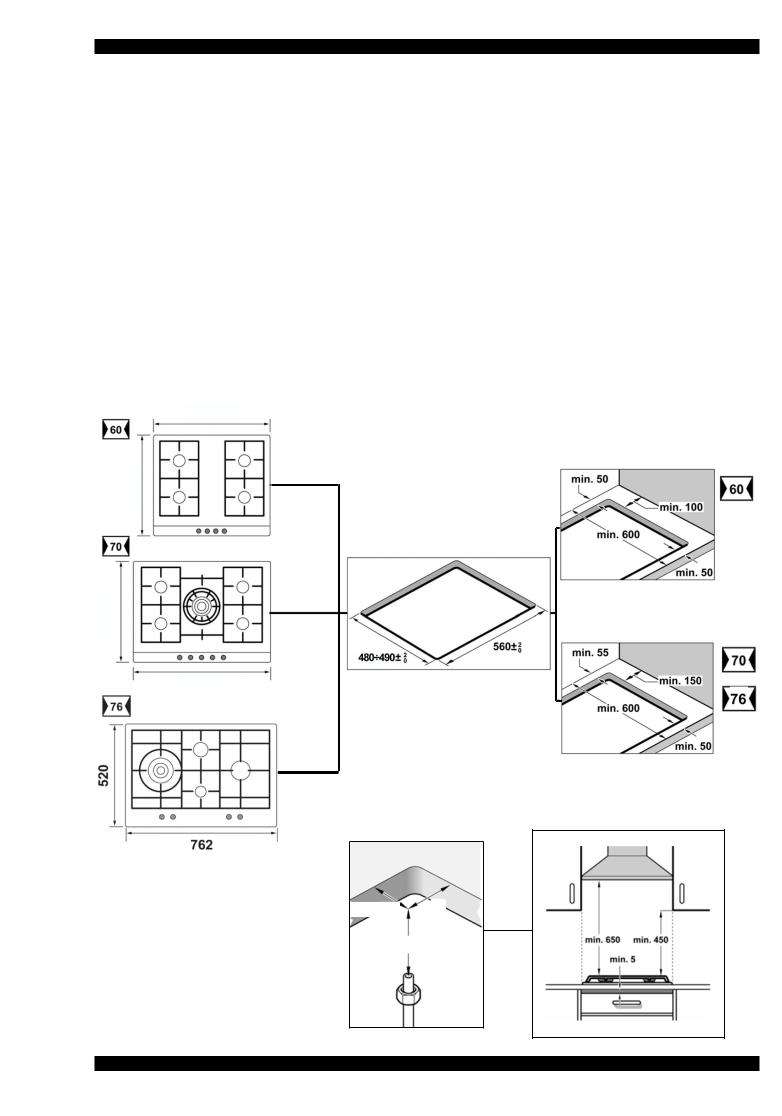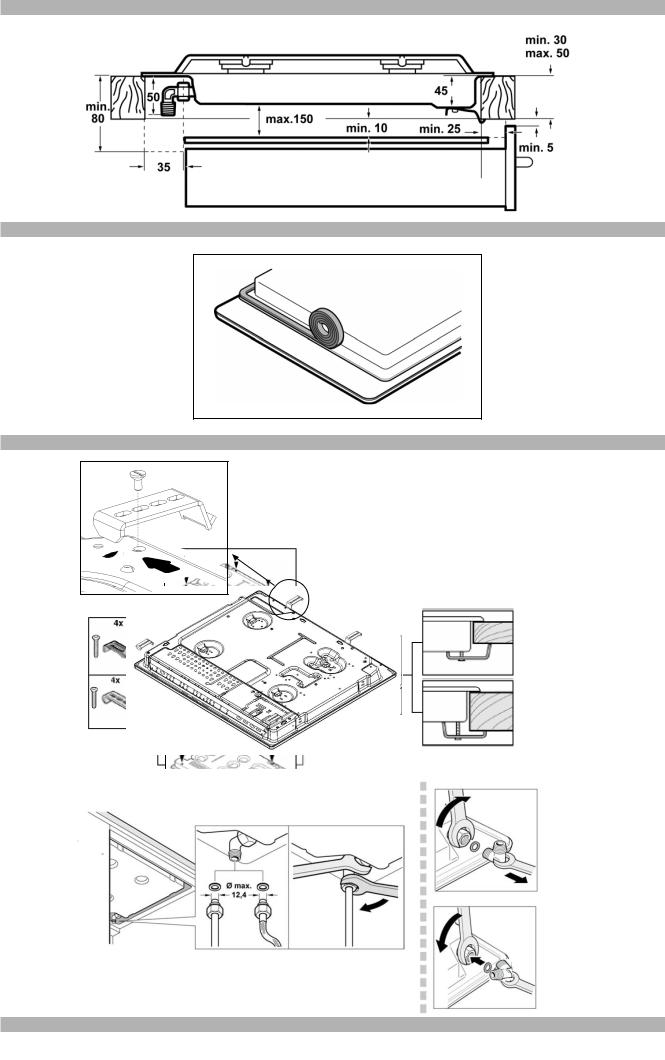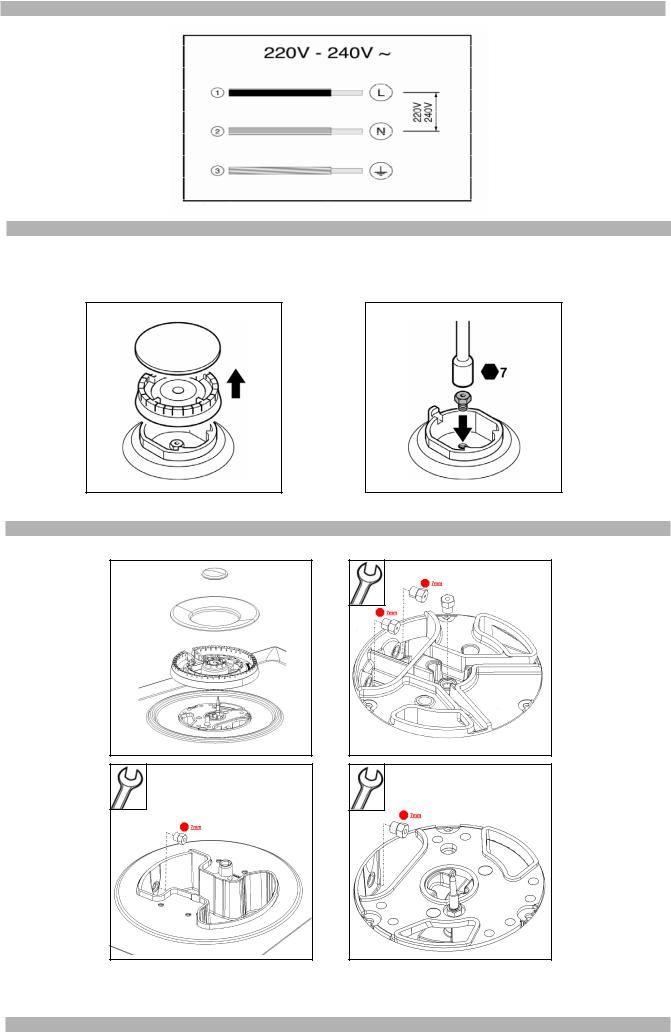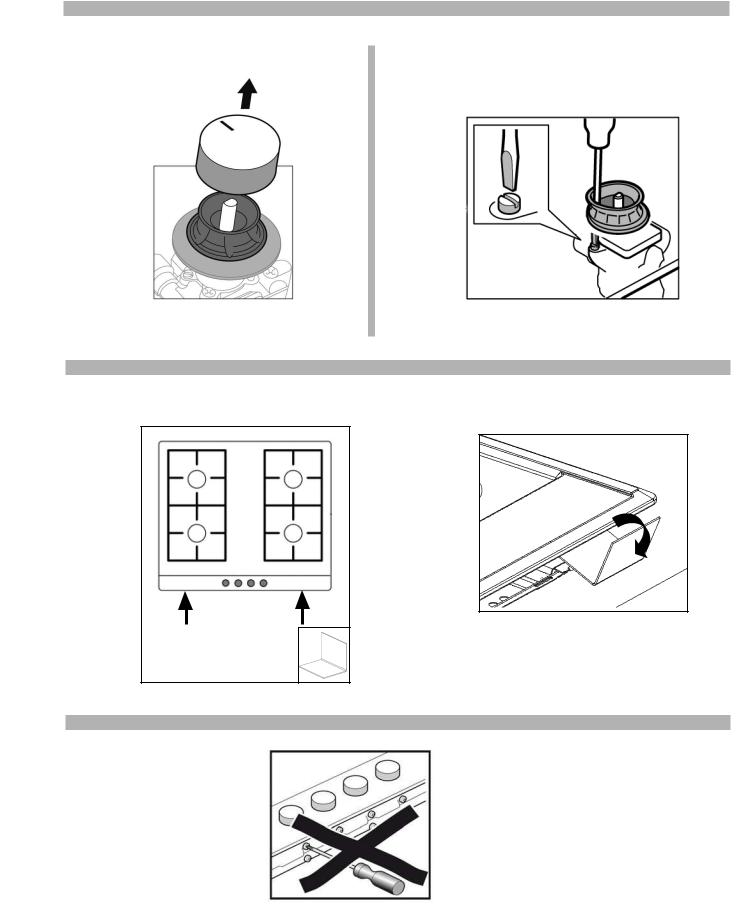BOSCH EC645HB90E, EC645YB80E, EC745RB90E, EC715QB80E, EC615PB80E User Manual [fr]
...
|
Assembly instructions |
|
|
|
|
Instruções de montagem |
|||||||
en |
pt |
||||||||||||
|
|
|
|
please keep |
|
|
|
|
por favor, guardar |
||||
|
|
|
Einbauanleitung |
|
|
|
|
|
Installatievoorschrift |
||||
de |
|||||||||||||
|
nl |
|
|||||||||||
|
|
|
|
bitte aufbewahren |
|
|
|
|
s.v.p. bewaren |
||||
|
|
|
Notice de montage |
|
|
|
|
|
|||||
fr |
|
|
|
|
Montaj talimatlarý |
||||||||
|
tr |
|
|||||||||||
|
|
||||||||||||
|
|
|
|
veuillez conserver |
|
|
|
|
lütfen saklayýnýz |
||||
|
|
|
|
|
|
|
|
|
|
|
|||
|
|
Istruzioni di Montaggio |
|
|
|
|
|
|
Руководство по монтажу |
||||
it |
|
|
|||||||||||
|
|
ru |
|
||||||||||
|
|
|
|
si prega di conservarle |
|
|
|
пожалуйста, сохраните данное руководство |
|||||
|
|
|
|
|
|
|
|
|
|
||||
|
|
Instrucciones de montaje |
|
|
|
|
|||||||
es |
|
|
|
||||||||||
|
pl |
|
|
Instrukcja monTAżU |
|||||||||
|
|
|
|
|
|
|
|||||||
|
|
|
|
por favor, guardar |
|
|
|
|
PL |
||||
|
|
|
|
|
|
|
|
ZACHOWAć |
|||||
|
|
|
|
|
|
|
|
|
|
|
|
|
|
|
|
|
|
|
|
|
|
|
|
|
|
|
|
1582
520
520
702
~19-..29 ~26
~50

2
3
4
|
|
|
|
|
|
|
|
5 |
|
5A |
|
|
|
||
|
|
|
|

6
7
7A

8 |
8 A |
9 |
10 |

en
Read the appliance's instructions before installing and using.
The graphics in these Assembly instructions are given as a guide only.
The manufacturer is exempt from all liability if this manual's requirements are not complied with.
Safety instructions
All installation, regulation and adaptation to other types of gas must be carried out by an authorised installation technician, respecting all applicable regulations, standards and the country's electrical and gas supply companies' specifications.
It is recommended that you call our Technical Assistance Service for adaptation to other types of gas. Before you begin, turn off the appliance's electricity and gas supply.
This appliance has been designed for home use only, not for commercial or professional use. This appliance cannot be installed on yachts or in caravans. The warranty will only be valid if the appliance is used for the purpose for which it was designed.
Before installing, you need to check that local distribution conditions (gas type and pressure) and the appliance's adjustment are compatible (see table I). The appliance's adjustment conditions are written on the label or the specifications plate.
This appliance can only be installed in a well-ventilated place in accordance with existing regulations and ventilation specifications. The appliance must not be connected to a combustion product evacuation device.
The supply cable must be attached to the unit to prevent it from touching hot parts of the oven or hob.
Appliances with electrical supply must be earthed.
Do not tamper with the appliance's interior. If necessary, call our Technical Assistance Service.
Before installing
This appliance is class 3 type, according to the EN 30-1-1 regulation for gas appliances: built-in appliance.
The units next to the appliance must be made of non-flammable materials. The laminated covering and glue for adhering it must be heat resistant. This appliance cannot be installed above fridges, washing machines, dishwashers or similar.
An oven must have forced ventilation to install a hob above it.
Check the oven's dimensions in its installation manual.
If an extractor fan is installed, you must follow the installation manual's instructions, always keeping a minimum vertical distance of 650 mm to the hob.
Preparation of kitchen unit (fig. 1-2)
Make an appropriate size cut in the work surface.
If the hob is electric or mixed (gas and electricity) and there is no oven below, place a non-flammable separator (e.g. metal or plywood) 10 mm from the bottom of the hob. This will prevent access to the base of the hob.
If the hob is gas, it is recommendable to place the separator at the same distance.
On wood work surfaces, varnish the cutting surfaces with a special glue. This protects them from moisture.
Installation of appliance
Depending on the model, the adhesive seal may be factory-fitted. If this is the case, it should not be removed under any circumstances, since the adhesive seal prevents leaks. If the seal has not been factory-fitted, apply it to the underside of the hob. Fig. 3.
In order to fit the appliance into the kitchen unit, tighten each of the clips as indicated allowing them all turn freely. Insert and centre the hob.
Press the sides of the hob until it is supported around its entire perimeter. Turn the clips and tighten them fully. The clips position depends on the thickness of the work surface. Fig. 4
Removal of hob
Turn off the appliance's electricity and gas supply.
Unscrew the clips and proceed in the reverse order to installation.
Gas connection (fig. 5)
The end of the inlet connection point of the gas hob has a 1/2” (20.955 mm) thread that allows for:
-fixed connection.
-connection using a flexible metal pipe (L min. 1 m - max. 3 m).
It is necessary to insert the watertight seal (034308) supplied between the manifold outlet and the gas supply. You must prevent the pipe from coming into contact with moving parts of the kitchen unit being inserted (for example, a drawer) and prevent access to any spaces which might become obstructed. If you need to connect the gas supply horizontally, our Technical Assistance Service can supply you with an L-tube (code 173018) and a seal (code 034308).
France: substitute the factory-fitted L-tube for the accessory bag. Fig. 5a. Please remember to insert the seal. Warning! If any connection is handled, check the seal.
Danger of leaks!
The manufacturer is not liable for any connection leaking, after being handled.
Electric connection (fig. 6)
Check that the voltage and power of the appliance are compatible with the electrical installation.
The hobs are supplied with a power cable with or without a wall socket plug. Provide an omnipolar cut-off switch with a minimum contact separation of 3 mm (except for plug connections, if the user has access to it).
Appliances with plugs must only be connected to sockets that have earth wires correctly installed.
This appliance is type “Y”: the supply cable can only be changed by the Technical Assistance Service and not the user. The cable type and minimum cross-section must be respected.
Changing the gas type
If the country's regulations allow, this appliance can be adapted to other types of gas (see specifications plate). The components required for this are in the transformation kit supplied (depending on the model) available from our Technical Assistance Service. The following steps should be taken:
A)Change the nozzles (fig. 7-7a):
- Remove the pan supports, burner covers and diffusers.
- Change the nozzles using the spanner provided by our Technical Assistance Service with code 340847 (for double and triple flame burners code 340808), see table II, taking special care to ensure that the nozzle does not fall when it is removed from the burner or when fitted.
Ensure that it is completely tightened in order to guarantee the seal. Primary air adjustment is not necessary with these burners.
B)Adjust the taps
Set the control knobs to minimum. Remove the control knobs from the taps. Fig. 8. It has an outer seal. Simply press on this seal with the tip of a screwdriver to allow access to the tap adjusting screw. Fig. 8a.
Never remove the seal.
Adjust the minimum ring setting by turning the by-pass screw using a flat head screwdriver.
Depending on the gas to which your appliance is going to be adapted (see table III), carry out the corresponding action:
A:firmly tighten the by-pass screws.
B:loosen the by-pass screws until the gas flow from the burners is correct: when adjusting the control knob between maximum and minimum, the burner does not go out, nor is there a flame backdraught created.
C:the by-pass screws need to be changed by an authorised engineer.
D:do not touch the by-pass screws.
If the by-pass screw cannot be accessed, disassemble the grease splash tray, which is fixed to the rest of the hob using a clip and screw mounting system. The following steps must be taken to remove the grease splash tray:
-Remove all the burner covers, pan supports and control knobs.
-Loosen the screws on the burners. Use the disassembly lever 483196 availablle from our Technical Assistance Service. To release the front clips, apply the lever to the area shown in figure 9. To assemble the grease splash tray again, proceed in the reverse order to removal.
It is important that all the seals are refitted to form a seal.
These devices are essential for the correct operation of the appliance as they prevent liquids and dirt from entering the appliance.
Refit the control knobs.

Never remove the tap spindle (fig. 10). In the event of a malfunction, change the whole tap.
Warning! After finishing, the sticker indicating the new type of gas must be placed close to the specifications plate.
DEde
Lesen Sie die Gebrauchsanweisung für das Gerät, bevor Sie es installieren und benutzen.
Die Abbildungen in dieser Anleitung dienen der Veranschaulichung.
Der Hersteller ist jeglicher Verantwortung enthoben, wenn die Bestimmungen dieses Handbuchs nicht eingehalten werden.
Sicherheitshinweise zu diesem Gerät
Alle Installations-, Regelungsund Umstellungsarbeiten auf eine andere Gasart müssen von einem autorisierten Fachmann und unter Beachtung der jeweils anwendbaren Regelungen und gesetzlichen Vorgaben sowie der Vorschriften der örtlichen Stromund Gasversorger vorgenommen werden.
Für Umstellungsarbeiten auf eine andere Gasart empfehlen wir, den Kundendienst zu rufen.
Stellen Sie vor der Durchführung jeglicher Arbeiten die Stromund Gaszufuhr ab.
Dieses Gerät wurde ausschließlich für die Verwendung in Privathaushalten entworfen; eine kommerzielle oder gewerbliche Nutzung ist nicht gestattet. Dieses Gerät darf nicht auf Jachten oder in Wohnwagen eingebaut werden. Die Garantie gilt nur dann, wenn das Gerät ausschließlich für seinen vorgesehenen Zweck genutzt wird.
Überprüfen Sie vor der Installation des Geräts, dass die örtlichen Voraussetzungen (Gasart und -druck) und die Geräteeinstellungen miteinander kompatibel sind (siehe Tabelle I). Die Bedingungen für die Geräteeinstellung finden Sie auf dem Etikett oder Typenschild.
Dieses Gerät darf nur an einem ausreichend belüfteten Ort und nur in Übereinstimmung mit den für die Belüftung geltenden Bestimmungen und Richtlinien eingebaut werden. Das Gerät darf nicht an einen Schornstein oder eine Abgasanlage angeschlossen werden.
Das Netzkabel muss am Einbaumöbel gut befestigt werden, damit es nicht mit heißen Teilen des Backofens oder des Kochfeldes in Berührung kommen kann. Elektrische Geräte müssen immer geerdet werden.
Hantieren Sie nie im Inneren des Gerätes. Rufen Sie gegebenenfalls unseren Kundendienst an.
Vor dem Einbau
Dieses Gerät entspricht Klasse 3 gemäß EN 30-1-1 für Gasgeräte: Einbaugeräte. Die neben dem Gerät befindlichen Möbel müssen aus nicht brennbaren Materialien sein. Die Schichtwerkstoffe
der Möbel sowie der sie zusammenhaltende Leim müssen hitzebeständig sein.
Dieses Gerät darf nicht über Kühlschränken, Waschmaschinen, Spülmaschinen oder ähnlichen Geräten eingebaut werden.
Wenn Sie das Kochfeld über einem Backofen installieren, muss dieser über eine Zwangsbelüftung verfügen. Überprüfen Sie die Abmessungen des Backofens in Ihrem Installationshandbuch.
Wenn eine Dunstabzugshaube angebracht wird, muss dies gemäß der Montageanleitung und immer unter Berücksichtigung eines vertikalen Mindestabstandes von 650 mm zum Kochfeld geschehen.
Vorbereitung des Küchenmöbels (Abb. 1-2)
Nehmen Sie in der Arbeitsfläche einen Ausschnitt mit den benötigten Abmessungen vor.
Wenn es sich bei dem Kochfeld um ein elektrisches oder gemischtes Kochfeld (Gas und elektrisch) handelt und sich kein Ofen darunter befindet, bringen Sie einen Zwischenboden aus nicht brennbarem Material (z.B. Metall oder Sperrholz) 10 mm unter dem Boden des Kochfeldes an. So wird ein Zugang zum unteren Teil des Kochfeldes verhindert. Wenn es sich bei dem Kochfeld um ein Gaskochfeld handelt, wird empfohlen, den Zwischenboden im selben Abstand zum Kochfeld anzubringen.
Bei Arbeitsflächen aus Holz firnissen Sie die Schnittflächen mit Spezialleim, um sie vor Feuchtigkeit zu schützen.
Einbau des Gerätes
Je nach Modell kann die Klebedichtung bereits im Werk angebracht worden sein. Die Klebedichtung dann keinesfalls entfernen, sie verhindert Durchsickern. Wenn die Dichtung nicht werkseitig angebracht wurde, kleben Sie sie an den unteren Rand des Kochfeldes. Abb. 3.
Zur Befestigung des Geräts im Einbaumöbel muss jede einzelne dieser Klammern soweit ansgeschraubt werden, dass sie sich frei drehen können.
Fügen Sie das Kochfeld mittig ein. Drücken Sie die Ränder solange nach unten, bis der gesamte Rand aufliegt. Drehen Sie die Klammern und ziehen Sie diese fest an. Die Position der Klammern ist abhängig von der Dicke der Arbeitsfläche. Abb. 4.
Ausbau des Kochfeldes
Trennen Sie das Gerät von der Stromund Gasversorgung.
Schrauben Sie die Klammern auf und folgen Sie den Einbauschritten in umgekehrter Reihenfolge.
Gasanschluss (Abb. 5)
Am Ende des Eingangsrohrs zum Gaskochfeld befindet sich ein 1/2” (20,955 mm) Gewinde. Dieses Gewinde ermöglicht:
-einen Festanschluss.
-einen Anschluss mit einem Metallschlauch (L min. 1 m - max. 3 m).
Die Dichtung (034308) (mitgeliefert) muss zwischen dem Auslass der Sammelleitung und dem Gasanschluss angebracht werden.
Es ist zu vermeiden, dass der Schlauch in Kontakt zu den beweglichen Teilen der Einbaueinheit gelangt (z. B. mit einer Schublade) und durch Öffnungen verlegt wird, die verschlossen werden könnten.
Wenn ein horizontaler Gasanschluss hergestellt werden soll, liefert Ihnen unser Kundendienst einen Krümmer mit der Teilenummer 173018 sowie eine Dichtung mit der Teilenummer 034308.
Für Frankreich: Ersetzen Sie den werkseitig montierten Krümmer mit dem, der sich im Zubehörbeutel befindet Abb. 5a.
Vergessen Sie nicht, dazwischen die Dichtung anzubringen.
Achtung! Nach Arbeiten an einer Anschlussstelle diese immer auf Dichtheit prüfen. Gasaustrittsgefahr!
Der Hersteller übernimmt für den Gasaustritt an einer Anschlussstelle, an der zuvor hantiert wurde, keine Verantwortung.
Elektrischer Anschluss (Abb. 6)
Prüfen Sie, ob Spannung und Nennleistung des Geräts mit der elektrischen Installation übereinstimmen.
Die Kochfelder werden mit Netzkabel mit oder ohne Stecker ausgeliefert.
Es muss ein allpoliger Trennschalter mit mindestens 3 mm Kontaktabstand angebracht werden (außer bei Anschluss an eine frei zugängliche Steckdose).
Mit Stecker ausgestattete Geräte dürfen nur in vorschriftsmäßig angebrachte, geerdete Steckdosen gesteckt werden. Das Gerät gehört zum Typ "Y". Das Zuleitungskabel darf nicht vom Benutzer, sondern nur vom Kundendienst ausgetauscht werden. Sowohl Kabeltyp als auch minimaler Querschnitt müssen berücksichtigt werden.
Umstellung auf eine andere Gasart
Wenn die einschlägigen Bestimmungen des jeweiligen Landes dies erlauben, kann dieses Gerät auf andere Gasarten umgestellt werden (siehe Typenschild). Die hierfür notwendigen Teile befinden sich im mitgelieferten Umbaukit (je nach Modell), das über den Kundendienst bezogen werden kann. Es müssen folgende Schritte befolgt werden:
A) Austausch der Düsen (Abb. 7-7a):
-Nehmen Sie die Roste, Deckel und Brennerkörper ab.
-Tauschen Sie die Düsen (siehe Tabelle II) mit dem über unseren Kundendienst erhältlichen Schlüssel mit der Teilenummer 340847 (für Doppelund Dreifachbrenner Teilenummer 340808) aus, wobei besonders darauf zu achten ist, dass die Düse beim Abdrehen oder Befestigen im Brenner nicht abbricht.
